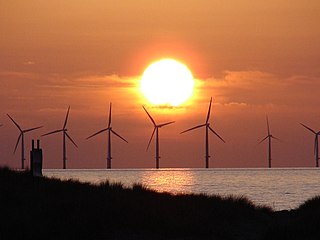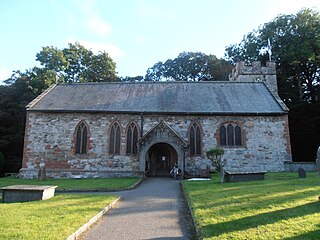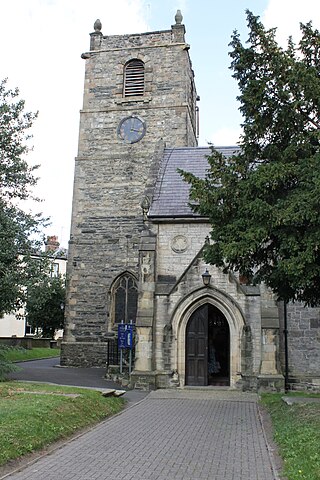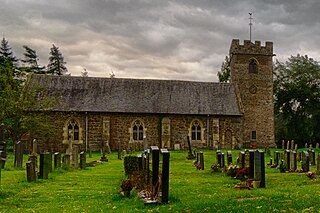
Pont Fawr crosses the River Conwy in the town of Llanrwst, Conwy County Borough, Wales. Traditionally attributed to the architect Inigo Jones, it was built in around 1636. The bridge is 51 m (167 ft) in length and carries vehicles and pedestrians. It is a Grade I listed building and a Scheduled monument.

Llangelynnin is a former parish in the Conwy valley, in Conwy county borough, north Wales. Today the name exists only in connection with the church, a school in the nearby village of Henryd, and the nearby mountain ridge, Craig Celynnin.

Llansannan is a rural village and community in Conwy County Borough, Wales. It lies on the bank of the River Aled and is about 8 miles to the south of Abergele and 9 miles (14 km) to the west of Denbigh. The population was 1,291 in 2001, with 67% able to speak Welsh. The figures for the 2011 census were: population 1,335 with 63% able to speak Welsh. The community includes the hamlets of Bylchau, Rhydgaled and Y Groes, and the lake Llyn Aled and reservoir Aled Isaf on Mynydd Hiraethog. Llansannan is in the traditional county of Denbighshire.

Llanfair Talhaiarn, abbreviated to Llanfair TH, is a village and community approximately 5 miles (8.0 km) south of Abergele in Conwy county borough, Wales. Until 1974 it was included in Denbighshire. The population was 979 in 2001, increasing to 1,070 at the 2011 census with 44% being Welsh language speakers.

Christ Church is a church of the Church in Wales, situated in Rossett, Wrexham County Borough, Wales. It is designated by Cadw as a Grade II listed building. Christ Church is an active Anglican church in the Alyn Mission Area, the archdeaconry of Wrexham and the diocese of St Asaph.

St Garmon's Church is in the centre of the village of Llanarmon-yn-Iâl, Denbighshire, Wales. It is an active Anglican church in the diocese of St Asaph, the archdeaconry of St Asaph and the deanery of Dyffryn Clwyd. It is designated by Cadw as a Grade I listed building.

St Michael's Church, Trelawnyd, is in the village of Trelawnyd, Flintshire, Wales. Former Anglican parish church. Previously in the benefice of Dyserth and Trelawnyd and Cwm, the deanery of St Asaph, the archdeaconry of St Asaph, and the diocese of St Asaph. The church is designated by Cadw as a Grade II* listed building.

St Mary's Church, Derwen, is a redundant church in the centre of the village of Derwen, Denbighshire, Wales. It is designated by Cadw as a Grade I listed building, and is under the care of the Friends of Friendless Churches. The churchyard contains Derwen Cross, an important medieval sculpture, which is listed at Grade II* and a Scheduled Ancient Monument.

Llannefydd is a village and community in Conwy County Borough, in Wales. It is located on the border with Denbighshire, between the Afon Aled and River Elwy, 5.7 miles (9.2 km) north west of Denbigh, 5.8 miles (9.3 km) south west of St Asaph, 6.9 miles (11.1 km) south of Abergele and 15.2 miles (24.5 km) south east of Conwy. In the 2011 census the community parish had a population of 590. The community includes the village of Cefn Berain and part of the hamlet of Bont Newydd.

Kinmel Bay and Towyn is a community in Conwy County Borough, in Wales. It is located on the coast bordering Denbighshire, from which it is separated by the River Clwyd, and is 2.6 miles (4.2 km) west of Rhyl, 2.5 miles (4.0 km) north east of Abergele and 14.1 miles (22.7 km) east of Conwy. The community includes the holiday resorts of Kinmel Bay and Towyn. It is crossed by the Afon Gele, which flows from west to east, before joining the River Clwyd on the eastern boundary. At the 2001 census the community had a population of 7,864, increasing to 8,460 at the 2011 census. Before being named Kinmel Bay there was a small settlement called Foryd, which is the name of the bridge crossing into Rhyl. Over half the population were born in England.

In the United Kingdom, the term listed building refers to a building or other structure officially designated as being of special architectural, historical, or cultural significance; Grade I structures are those considered to be "buildings of exceptional interest". Listing was begun by a provision in the Town and Country Planning Act 1947. Once listed, strict limitations are imposed on the modifications allowed to a building's structure or fittings. In Wales, the authority for listing under the Planning Act 1990 rests with Cadw.

The Church of St Dyfnog, Llanrhaeadr-yng-Nghinmeirch, Denbighshire, Wales, is a parish church dating from the 13th century. The church is most famous for its Tree of Jesse window which dates from 1533. The church is a Grade I listed building.

St Collen's Church is a parish church in the town of Llangollen, Denbighshire, Wales. The first church on the site was founded by Collen in the 6th century. Nothing of this building remains. A new church was built in the 13th century, in the Early English Gothic style. This was developed in the succeeding centuries, and then almost completely rebuilt in the 19th century. The architect of the Victorian reconstruction was Samuel Pountney Smith, who retained little of the earlier church, with the exception of the tower. The churchyard contains the grave of the Ladies of Llangollen, Eleanor Charlotte Butler and Sarah Ponsonby, and their servant Mary Carryl, who lived at the nearby Plas Newydd. In November 2021 the first blessing of a gay partnership in a Church in Wales church was held at St Collen's. The church is an active parish church in the Diocese of St Asaph. It is designated by Cadw as a Grade I listed building.

Golden Grove is an Elizabethan house to the west of the village of Llanasa, Flintshire, Wales. The mansion dates from 1578 and was built by Sir Edward Morgan, an official at the court of Elizabeth I. In the 19th century the estate was bought by Henry Pochin, owner of Bodnant Hall in neighboring Conwy, whose daughter, Laura, laid out the grounds at Golden Grove. The house is designated by Cadw as a Grade I listed building and the gardens and grounds are designated Grade II on the Cadw/ICOMOS Register of Parks and Gardens of Special Historic Interest in Wales.

Henblas is an Renaissance house in the village of Llanasa, Flintshire, Wales. The mansion dates from 1645 and was built by the Morgan family of Golden Grove, a country estate to the west of Llanasa, as a home for two unmarried sisters. The house is designated by Cadw as a Grade I listed building.

St Bilo's Church, is an active parish church in the village of Llanfilo, Felin-fach, Powys, Wales. The dedication is to Bilo, one of the 24 children of Brychan, a legendary 5th-century king of Brycheiniog. Dating from the 12th century, with later additions, the church was restored by W. D. Caröe in the early 20th century. St Bilo's is designated by Cadw as a Grade I listed building.

The Church of St Tysilio and St Mary is an active parish church in the village of Meifod, Powys, Wales. The village lies seven miles (11 km) north-west of Welshpool. The site has been a centre of Welsh Christianity since c.500 and the present, unusually large, churchyard forms part of what was an early clas settlement. The origins of the present church are of the 12th century. The dedications are to Tysilio and to Mary, mother of Jesus. Tysilio was a 6th/7th century Welsh noble and Bishop of St Asaph who reputedly founded an early church, the Eglwys Tysilio, at Meifod. The church is a Grade I listed building. The Royal Commission on the Ancient and Historical Monuments of Wales (RCAHMW) considers Ss Tysilio and St Mary, "a display of Welsh Christianity through the centuries".

St Aelhaiarn's Church is an active parish church in the village of Guilsfield, Powys, Wales. The village lies 3 miles to the north of Welshpool. The present church dates mainly from the 14/15th centuries, although parts may date back to the 12th. It was restored by George Edmund Street in 1877–1879. The church is designated by Cadw as a Grade I listed building. Its churchyard, which contains a group of ancient yew trees, is designated at Grade II* on the Cadw/ICOMOS Register of Parks and Gardens of Special Historic Interest in Wales.

St Benedict's Church is an active parish church in Gyffin, Conwy, Conwy County Borough, Wales. Formerly a village, and now a suburb of the town, Gyffin lies immediately south of Conwy on the south bank of Afon Gyffin. Cadw records that the present church dates from c.1300, although possibly with earlier origins. The church is designated a Grade I listed building.

St Mary's Church is an active parish church in Caerhun, Conwy County Borough, Wales. A scattered settlement, Caerhun lies 6.5 km to the south of Conwy. The church stands in the north-east corner of the remains of the Roman fort of Canovium. Its wider setting is the 19th century parkland of Caer Rhun Hall. Cadw records that the church dates from the 13th century. It is a Grade I listed building, and the Caer Rhun parkland within which is sited is listed on the Cadw/ICOMOS Register of Parks and Gardens of Special Historic Interest in Wales.





















